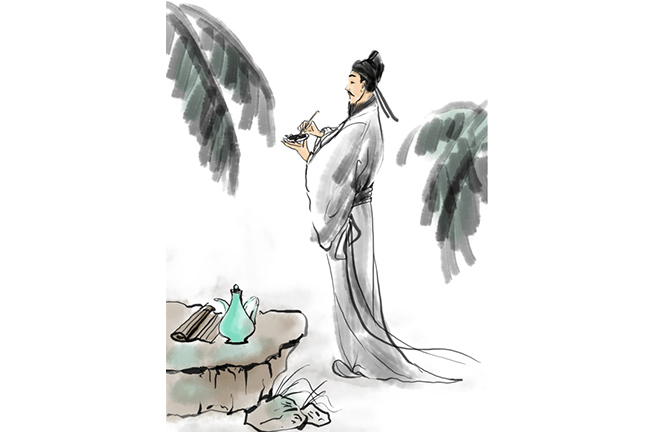An analysis of different English versions of Li Bai’s poetry

FILE PHOTO: A portrayal of the Chinese poet Li Bai
Among the luminaries of Tang poetry, Li Bai’s poetry is a pearl shining with dazzling brightness. Although there have always been debates about the translatability of poetry, efforts to translate poetry have never ceased among scholars. Translation of Li’s poetry into English has continued from the mid-18th century to this day. Versions from different groups of translators have their own merits, and through diverse translation styles, the cultural interactions have in different ways fostered the dissemination and acceptance of Li’s poetry in the West.
Three translation stages
The early stage of translating Li’s poetry into English occurred before the beginning of the 20th century. When missionaries arrived in China at the end of the 16th century, a large number of works translating Chinese poems into English were produced as a product of the collision between cultures. According to Chinese scholar Wang Lina, it was Soame Jenyns, a British politician and poet, who first translated Li’s poetry into English. Afterwards, attempts to translate Li’s works were followed by John Francis Davis, James J. Legge, Robert Douglas, and Herbert Allen Giles.
During this period, most of the translators were British, and they did not study Li’s poetry as an independent research object, but as part of Chinese cultural classics or Tang Dynasty literature. A small number of poems were translated, and they suffered from insufficient research depth. Influenced by the cultural differences between China and the West, translators often misinterpreted or misunderstood the original meaning of source texts. Moreover, influenced by Western poetry creation trends, most translators adopted the prose form of translation, which did not reproduce the original poetry’s rhythmic beauty.
The second translation period was in the first half of the 20th century, during which the translation of Li’s poetry entered a new phase alongside the gradual formation of translation criteria. At that time, the US began to play a new role in the world arena, becoming increasingly active in politics, economics, and culture. Some representative translators of Li’s poetry also appeared.
An archetype of those who translated Chinese poetry into English in free style, Ezra Pound is one of the pioneers who led Chinese poetry into the American world. His Cathay and Lustra, two works of translation, respectively included 7 and 12 of Li’s poems. Extending beyond the restrictions of metrical rules and forms (the rhythmic arrangement of syllables) for classical poetry, Pound put more emphasis on conveying the artistic elements and poetic mood of the poems, which made his translation popular with Western readers.
The contributions of Japanese translator Shigeyoshi Obata also cannot be ignored. During his studies in the US, he published The Works of Li Po, the Chinese Poet in English. Like Pound, he adopted a free-style prose translation method, free from form and rhythm, and aimed to convey to readers the thoughts and emotions embodied in the original poems.
During this period, Li’s poetry translation by American translators began to surpass their British counterparts in both quantity and quality, and the group of translators grew from missionaries and diplomats to professional translators and poets, which may be attributed to the vigorous new poetry movement which emerged in America. At its height, the movement used ancient Chinese poetry as a weapon in an attempt to break the limitations of British traditional poetry that had long prevailed.
The third translation stage followed after the mid- to late 20th century. In this stage, especially after the end of the 20th century, domestic Chinese translators began to make great efforts in translating Chinese poetry into English. A multitude of translators emerged, with remarkable contributions made to introduce more Western readers to Chinese classical poetry. Representative Chinese translators are Weng Xianliang, Xu Yuanchong, and so on.
Different focuses of diverse versions
Generally speaking, the foreign versions of Li’s poetry are mainly in prose form, while the domestic versions are mainly in verse form. There has always been a dispute between verse and prose forms of poetry translation, and the heart of the debate is whether the rhythmic rules of the original poem should be preserved in translation. In fact, we can see that the verse-form translation is biased towards linguistics, which demonstrates more of the linguistic features of poetry, while the prose-form of translation tends to emphasize the social attributes embodied in poetry. The two types of translation are connected to each other, but with different preferences.
In addition, it is common for the translators to deviate from the principle of being loyal to the source texts out of contextual consideration and even market effects. On the whole, translators of Li’s poetry can be classified into four groups: missionaries or diplomats who usually domesticate the Chinese poetry to meet local demand; Sinologists or British and American scholars who focus on reproduction of the literary significance and profundity of Li’s poetry; poets who value the aesthetic effects of the target texts; and Chinese translators who pay more attention to the conveyance of Chinese cultural elements. Through their efforts, the English versions of Li’s poetry, while boosting the study and dissemination of classical Chinese literature, also enrich English literature to some extent, and foster interactions between cultures and civilizations of China and the West.
Lyu Wenpeng and Chen Lei are from the College of Foreign Languages & Literature at Northwest Normal University.
Edited by BAI LE

 PRINT
PRINT CLOSE
CLOSE